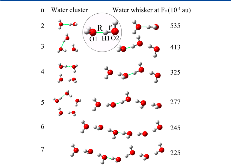Electric Field Effects on the Intermolecular Interactions in Water Whiskers: Insight from Structures, Energetics, and Properties
- Jilin Univ., Changchun (China)
- South China Normal University, Guangzhou (China)
- Oak Ridge National Lab. (ORNL), Oak Ridge, TN (United States)
Modulation of intermolecular interactions in response to external electric fields could be fundamental to the formation of unusual forms of water, such as water whiskers. However, a detailed understanding of the nature of intermolecular interactions in such systems is lacking. In this study, we present novel theoretical results based on electron correlation calculations regarding the nature of H-bonds in water whiskers, which is revealed by studying their evolution under external electric fields with various field strengths. We find that the water whiskers consisting of 2-7 water molecules all have a chain-length dependent critical electric field. Under the critical electric field, the most compact chain structures are obtained, featuring very strong H-bonds, herein referred to as covalent H-bonds. In the case of a water dimer whisker, the bond length of the novel covalent H-bond shortens by 25%, the covalent bond order increases by 9 times, and accordingly the H-bond energy is strengthened by 5 times compared to the normal H-bond in a (H2O)2 cluster. Below the critical electric field, it is observed that with increasing field strength, H-bonding orbitals display gradual evolutions in the orbital energy, orbital ordering, and orbital nature (i.e., from typical -style orbital to unusual -style double H-bonding orbital). We also show that beyond the critical electric field, a single water whisker may disintegrate to form a loosely bound zwitterionic chain due to a relay-style proton transfer, whereas two water whiskers may undergo intermolecular cross-linking to form a quasi-two-dimensional water network. In conclusion, these results help shed new insight on the effects of electric fields on water whisker formation.
- Research Organization:
- Oak Ridge National Laboratory (ORNL), Oak Ridge, TN (United States). Center for Nanophase Materials Sciences (CNMS)
- Sponsoring Organization:
- USDOE Office of Science (SC)
- Grant/Contract Number:
- AC05-00OR22725
- OSTI ID:
- 1265297
- Journal Information:
- Journal of Physical Chemistry. A, Molecules, Spectroscopy, Kinetics, Environment, and General Theory, Vol. 119, Issue 10; ISSN 1089-5639
- Publisher:
- American Chemical SocietyCopyright Statement
- Country of Publication:
- United States
- Language:
- English
Web of Science
Energetic aminated-azole assemblies from intramolecular and intermolecular N–H⋯O and N–H⋯N hydrogen bonds
|
journal | January 2016 |
One-dimensional water nanowires induced by electric fields
|
journal | January 2019 |
Some measures for making a traditional halogen bond be chlorine-shared or ion-pair one in FCl•NH 3 complex
|
journal | November 2016 |
Some measures for making a traditional halogen bond be chlorine-shared or ion-pair one in FCl•NH3 complex
|
text | January 2016 |
Some measures for making a traditional halogen bond be chlorine-shared or ion-pair one in FCl•NH3 complex
|
text | January 2016 |
Similar Records
Effects of Weak Intermolecular Interactions on the Molecular Isomerism of Tricobalt Metal Chains
Ligand field and intermolecular interactions tuning the magnetic properties of spin-crossover Fe(II) polymer with 4,4′-bipyridine









